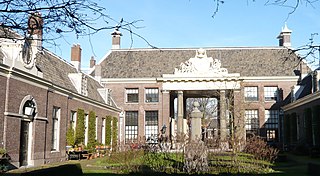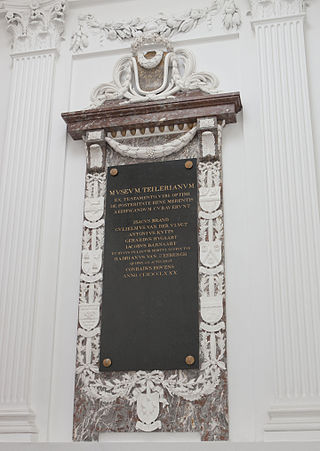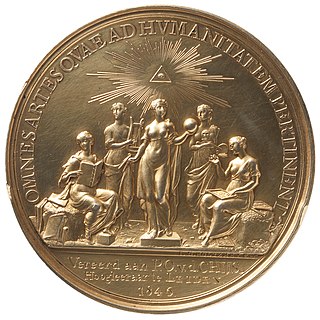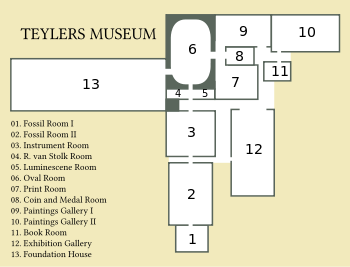
Teylers Museum is an art, natural history, and science museum in Haarlem, Netherlands. Established in 1778, Teylers Museum was founded as a centre for contemporary art and science. The historic centre of the museum is the neoclassical Oval Room (1784), which was built behind the house of Pieter Teyler van der Hulst (1702–1778), the so-called Fundatiehuis. Pieter Teyler was a wealthy cloth merchant and banker of Scottish descent, who bequeathed his fortune for the advancement of religion, art, and science. He was a Mennonite and follower of the Scottish Enlightenment.

The Teylershofje is a hofje in Haarlem, Netherlands with 24 houses.

Martin(us) van Marum was a Dutch physician, inventor, scientist and teacher, who studied medicine and philosophy in Groningen. Van Marum introduced modern chemistry in the Netherlands after the theories of Lavoisier, and several scientific applications for general use. He became famous for his demonstrations with instruments, most notable the Large electricity machine, to show statical electricity and chemical experiments while curator for the Teylers Museum.

Pieter Teyler van der Hulst was a wealthy Dutch Mennonite merchant and banker, who died childless, leaving a legacy of two million florins to the pursuit of religion, arts and science in his hometown, that led to the formation of Teyler's Museum. This was not the value of his entire estate. He also founded Teylers Hofje in his name, and made important donations to individuals in the Mennonite community.

Cornelis Hofstede de Groot, was a Dutch art collector, art historian and museum curator.

Adriaan van der Willigen was a Dutch writer of plays and travelogues who is mostly remembered today for his comprehensive list of painter biographies.

Vincent Jansz. van der Vinne, was a Dutch 18th century painter and the great-grandson of Vincent van der Vinne.

The Teylers Stichting is a Dutch foundation founded with the heritage of the Dutch 18th century cloth merchant and banker Pieter Teyler van der Hulst to support the people in need and encourage worship, science and art.

Jacobus Barnaart was a Dutch merchant and one of the five first directors of the Teylers Stichting.

The Teylers astronomical observatory is an astronomical observatory built in 1784 on the roof of the Oval Room of the Teylers Museum in Haarlem.

Teylers Eerste Genootschap, also known as the Godgeleerd Genootschap is one of the two societies founded within the Teylers Stichting as a result of the will of the Dutch 18th-century merchant Pieter Teyler van der Hulst. The First Society is focused on theology, while the Second Society is focused on art and science.

Teylers Tweede Genootschap, also known as the Wetenschappelijk Genootschap is one of the two societies founded within the Teylers Stichting with the purpose to promote and award prizes for research. They were the result of the testament of the Dutch 18th-century merchant Pieter Teyler van der Hulst. The Second Society is focused on art and science, while the First Society is focused on theology.

The Eerste Schilderijenzaal, or Painting Gallery I, is one of two art gallery rooms in Teylers Museum and is the oldest art gallery for contemporary Dutch art in the Netherlands. It was built onto the back of Teylers Oval Room in 1838. It was the young museum's first exhibition space for paintings and could be entered through the Oval Room, which was itself located behind the Fundatiehuis, the former home of Pieter Teyler van der Hulst.

The Tweede Schilderijenzaal, or Painting Gallery II, is one of two art gallery rooms in Teylers Museum. The Tweede Schilderijenzaal was built in 1893 as an extension of the first gallery.

The Instrument Room is a room in Teylers Museum which houses a part of the museum's Cabinet of Physics: a collection of scientific instruments from the 18th and 19th centuries. The instruments in the collection were used for research as well as for educational public demonstrations. Most of them are demonstration models that illustrate various aspects of electricity, acoustics, light, magnetism, thermodynamics, and weights and measures. The rest are high-quality precision instruments that were used for research.

The Fossil room II is one of two paleontological display rooms in Teylers Museum. The Fossil room II was built in 1885 as an extension of the first Fossil room I, under the direction of the architect Ad van der Steur Jr.

The Teylers Coin and Medal Room, or Numismatisch Kabinet, is a small display room in Teylers Museum that was designed in 1888 and furnished with special display cabinets in 1889.



















